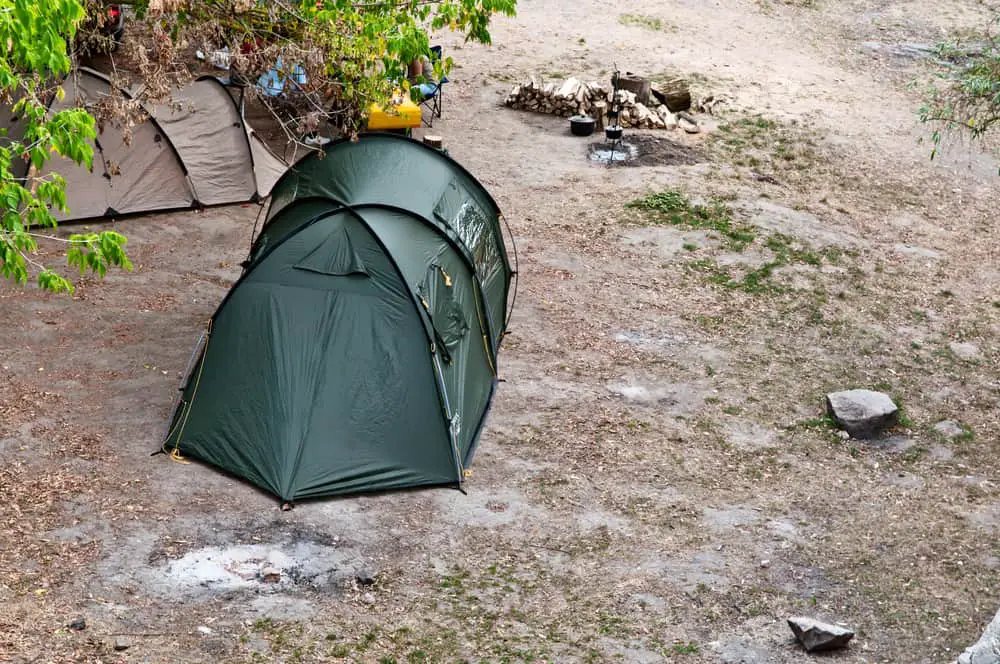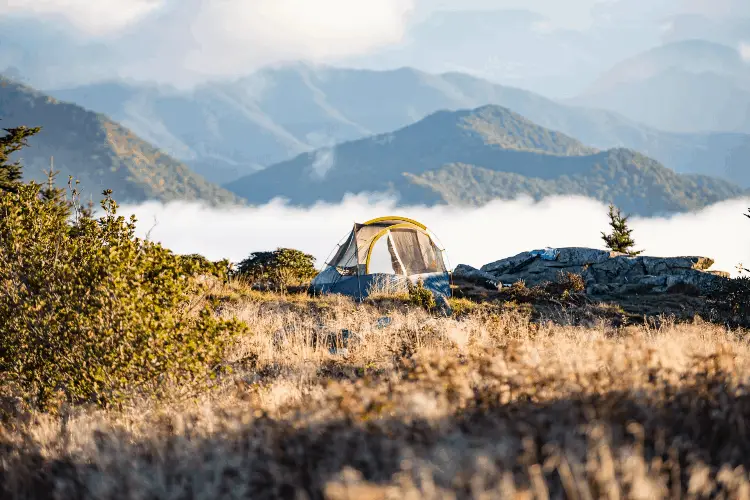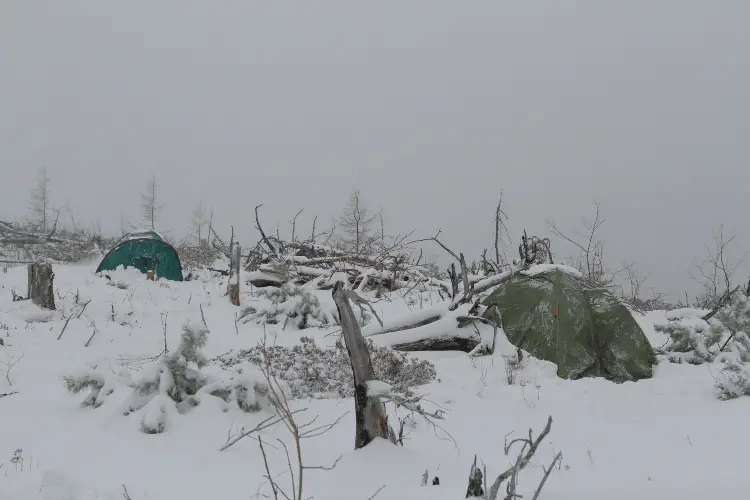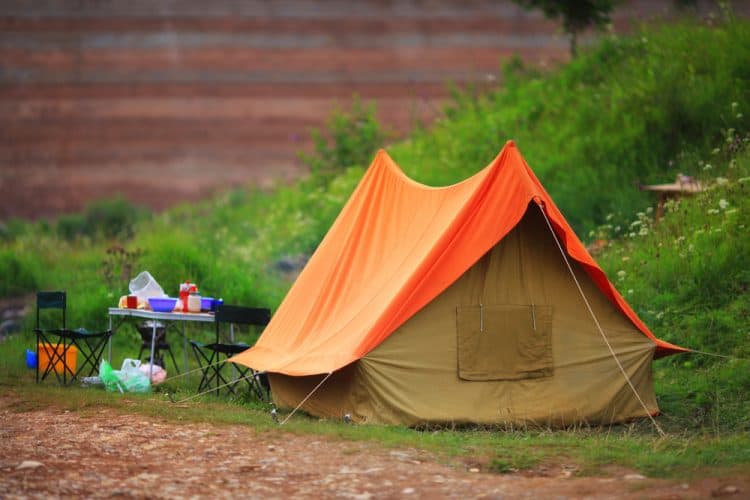How To Dry A Tent Fast And Easy – A Complete Guide
Nothing is worse than putting away a wet tent.
Aside from being a risk to your expensive gear, it just sucks when everything is all wet.
The point of your tent is to keep you dry, so it helps to keep it dry too. It’s just the nice thing to do for a piece of gear that exists to protect you.
But how to dry a tent fast, you might ask?
To dry a tent fast, whether at camp or at home, you need to remove moisture, get rid of condensation, and fight mold. You can even use drying kits for tents. We discuss all this plus many more tips later in our guide.
We will show you how to save yourself a lot of headaches. Look after your gear, and it will look after you.
So if you want to learn our insider tips, proven to work well anytime, you’re going to love this guide.
Let’s dive right in.
Why is it essential to dry your tent?
You want to dry your tent on a camping trip before packing it, so it isn't wet when you set it up the next night.
Putting a damp tent into your pack or compression bag risks getting other gear wet, which will make camping not being fun at all.
That's even if you put your tent in the tent bag. As you probably know, those are not waterproof.
If you are only going out for one night or staying in the same spot, you can worry about drying your equipment when you get home.
After your camping trip, you want to make sure your tent is completely dry before putting it away, so mold and mildew don't form. Because water can get trapped in the seams, often leading to mold build-up.
This mold can lead to the tent leaking in the future and the health risks of camping in a moldy tent.
Things get even more complicated if you're using tent accessories such as a tent carpet, for example.
Plus, if you want to black out your tent and keep it cool, you can do so only if it's dry.
How to dry a tent fast at camp after rain or dew?
When it rains, you end up with a wet tent from both the precipitation and the condensation from the bodies in the tent.
Usually, when it is raining, you zip up your tent to keep the water out, but this tends to reduce ventilation. If you combine the lack of ventilation with the cooling of the rain fly by the water falling on it, you have a recipe for a humid environment in the tent.
Everything tends to be damp, with condensation saturating the inside surface of the rain fly.
In the next paragraphs, I will show you what tips work for me when it comes to drying my tent at camp. Fast.
Minimize moisture build-up
The first thing you can do to dry your tent is minimizing moisture build-up beforehand. Peg out the sides of the tent to allow more ventilation.
If your tent has top vents, make sure they are open. Unless the rain is too heavy, consider having the zippers of the vestibules open slightly to allow move air movement.
You are constantly giving off moisture, so you want to get as much of it out as possible. In that way, it won’t build up on the inside of the tent.
Even if it doesn't rain, morning dew can get your tent soaked. When the moisture in the air cools overnight, it condenses back into liquid water.
This moisture gets deposited on items that have cooled, like your tent rain fly. It will also increase the amount of condensation inside the tent rain fly as it has gotten cooler.
To reduce moisture build-up in your tent, use a UCO Candle Lantern before bed and when you first get up.
Hang the lantern from the roof of your tent to create a convective current that will dry out the tent. Depending on how humid it is, it will take 20-60 minutes to dry out the condensation.
Sure enough, a properly set up campfire helps with that too.
Renew the DWR
The first thing you can do to make sure your tent dries fast is to renew the durable water repellent (DWR) coating on the rain fly.
This will keep water beading and running off rather than sitting on the surface. Most outdoor stores and online retailers sell a spray that is easy to apply.
Nik Wax and Granger's brands work well and are simple to use. To apply, you will spray on and let dry.
Do this outside where you have good ventilation. Make sure to spray the inside and outside of the rainfly.
Camp towel to the rescue
If you have a build-up of condensation on the inside of your tent, use a synthetic chamois towel to wipe it down.
Like the crazy guy from the infomercial says, camp towels are super absorbent and are almost completely dry when you wring them out.
Give it a shake
Most of the moisture will be on the rain fly. The outside will have rain or dew and the inside condensation.
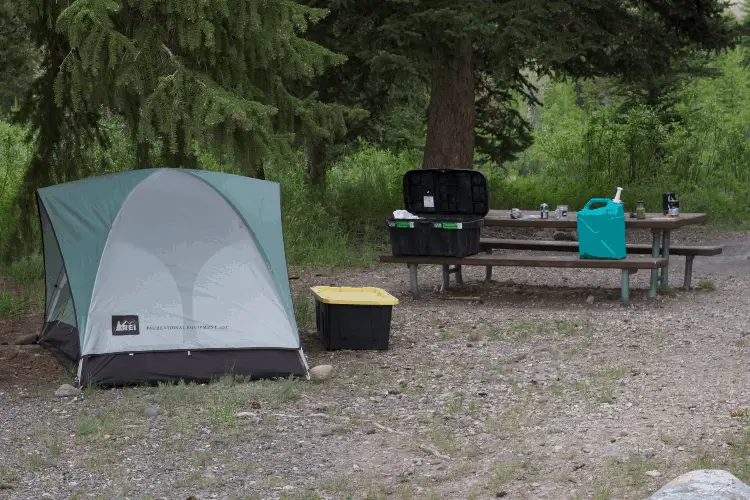
Freestanding tents are easy to dry. You can just turn it off and shake it to remove excess water.
Once you've wiped off what you can from the inside, lift off the fly and give it a shake. This gets most of the water off of it.
Make sure to do this away from your tent body and other gear to not get water all over those items.
If your tent bottom is in standing water, then shaking or wiping off the bottom will speed up drying the tent body.
If your tent is a free-standing model, like the ones described in our article on the top-rated tents for stargazing, for example, you can pick up the whole thing once you remove the rainfly and turn it over to get the moisture off the bottom.
Hang It Up
As long as the rain has stopped, hanging your rainfly and tent body up will let it dry out pretty quickly.
A tree branch (chances to find one fast are better if you’re camping in the woods) or improvised clothesline will allow you to get the tent off the ground and allow air movement all around. If you're camping in a windy spot, just let the high winds do their job.
If possible, place it in the sun for an even quicker drying time. While ultraviolet rays will break down the fabric over time, the limited time you will need to leave it in the sun to dry it out will not damage your tent.
UV will also help protect against mold. Plus, science has proven that UV light repels annoying bugs.
Avoid putting the tent close to a kindled fire, as this poses obvious risks, especially if the fire is unattended.
How to dry a tent in winter?
In winter, snow on the outside and frost build-up on the inside are the issues you will face. As long as you don't have liquid water in your tent, drying it off is as easy as brushing off the snow and frost.
Using a candle lantern in your tent will help to reduce the moisture in the air. The lower humidity will mean less frost on the inside of the fly.
It can also add some warmth to the tent, making going to bed and getting dressed in the morning less frigid.
How to dry a tent quickly at home?
Once you get home from a camping trip, the first thing you should do is unpack your gear and dry out your tent.
It's easy to put your pack in the corner and plan to get to it later, but I've ruined an expensive tent this way.
I was lazy and didn't unpack for about a week. When I took my tent out of its stuff sack, it was covered in mold and smelled like a wet basement.
If you have space, set up your tent indoors. This way you don't have to worry about rain. If you give it a few hours, the tent will be completely dry.
When I lived in an apartment, I would set my tent up in the living room. I made a clothesline between door frames with paracord to be able to hang the rainfly.
Tie a stopper knot at the end of the cord, place the line over the top of the door and close it. When you pull on the rope, the knot won't pull through.
Attach the other end over another door or tie it to a solid object. This will give you something to attach the rainfly to, so it is off the floor and has airflow all around.
When drying it out indoors, it helps to increase ventilation, such as using a fan or opening windows to create a cross breeze.
If you don't have the room for this, you can set it up in the backyard or in a local park. If you can find a covered area such as a gazebo, then you can still dry out your tent on a rainy day.
Here are some more quick tips to dry your tent at home. I’ve tried them, so they are proven to work:
- If it is a dry day, open the windows to increase ventilation
- Wipe off any liquid water and dirt
- Use a fan to create more airflow
- Flip your tent to dry all sides
What not to do to dry out a tent
Here are some things you should avoid doing when trying to dry your tent. Again, based on real-life experience.
- Don't use heat devices such as a hairdryer.
- Avoid high-speed wind such as a leaf blower.
- Don't wait days before unpacking your tent and drying it out.
Can you dry a tent in the dryer?
Don't put your tent in the dryer.
Ever.
Even on low, the heat can be enough to cause the seam sealing to delaminate. The bug netting in the tent body can get torn. I know as I've tried this. Plus, the spinning of the tumbler will get all the cords tangled.
How long does it take for a tent to dry?
How long a tent takes to dry will depend on its material and how wet it is. If the air is humid, it will take longer for your tent to dry out.
Generally, you will be looking at 20-60 minutes if you have removed any standing water from the fly or floor of the tent.
And if the tent has mesh porous walls, like most of the 3-season tents for hot weather, it would be even easier
How to dry a canvas tent?
Canvas is made of cotton that is treated with a water repellent coating. Due to this, it will tend to absorb more water than a nylon tent.
The same techniques you use to dry a synthetic material tent will apply to a canvas tent. Only it will take longer.
While not at risk of melting, I would avoid putting a canvas tent in a dryer as cotton shrinks, and the tent's weight could damage the machine.
Since canvas tents are often on the larger side, you can put a fan inside to increase airflow.
Using Drying kits for tents
To maximize the speed of drying your tent, you should put together a drying kit. You can use this at the campsite and at home.
Camp Towel
A microfiber camp towel is a multi-function item that you should be bringing with you on camping trips anyway.
I use them for personal hygiene, cleaning my glasses, and drying my tent. Pack Towel and Sea to Summit make great quality versions in multiple sizes. They are very absorbent, but dry quickly. That makes them well suited for camp use, especially wiping up any water in and on your tent.
Fan
At home, a plug-in fan will speed up the process of drying your tent by quite a bit. But if you are car camping, you can also bring along a battery-powered or fan that will run from the power outlet from your car.
When not in your tent, you can use it to keep cool on those hot summer days.
Candle lantern
The mighty UCO Candle Lanterns add warmth and mood lighting to your tent, but the most helpful function is decreasing condensation in your tent.
They come in one or three candle versions, depending on the size of your tent. As with any combustion inside a tent, make sure you have adequate ventilation.
This is important for avoiding carbon monoxide poisoning, but the ventilation will also help reduce the moisture in your tent.
How long can you leave a tent wet?
Mold can take as little as 24 hours to form, so you don't want to leave your tent wet for long periods.
Mold is a fungus that is distributed by spores in the air. They need a damp location to grow. It is standing moisture that is the risk for mold, so when the rain stops, try to dry out your tent as quickly as possible. Keeping your tent set up in the exact location while it is wet will increase the risk of mold. Even if you are staying at the same campsite, air out your tent and dry the bottom.
Sun exposure will help reduce the risks associated with mold build-up by speeding drying and anti-fungal UV rays.
Conclusion
Your tent is a significant investment, so you want to look after it. When it's done keeping you dry, it is up to you to keep it dry.
Get better performance, be more comfortable, and avoid mold by using our tips to dry your tent quickly on trips and at home before storage.
See you outdoors!
What are your best tips for drying a wet tent? Leave a comment below!
Winston Endall
Having worked in the outdoor, fitness, and cycling industry his whole life, Winston brings a wealth of real world knowledge on the topics. Rock climbing, backpacking, cycling and wilderness survival are his life. As both an athlete, coach and outdoor educator, his practical experience translates into his writing to help people better pursue their outdoor passions.. Read more about Winston here.

